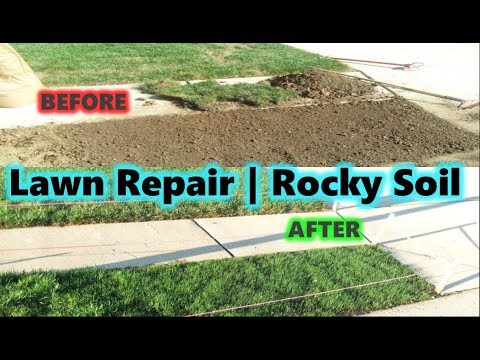To plant grass in rocky soil, amend the soil by adding organic matter and topsoil. Grass will grow better in soil that is well-draining and nutrient-rich.
When planting grass in rocky soil, it can be challenging to achieve successful growth due to the lack of nutrients and poor drainage. However, by following a few steps, you can improve the soil conditions and establish healthy grass. One effective method is to amend the rocky soil by adding organic matter such as compost or aged manure, which will enrich the soil with essential nutrients.
Additionally, incorporating topsoil into the rocky soil will help improve drainage and provide a better environment for the grass to grow. By taking these measures, you can overcome the challenges of planting grass in rocky soil and achieve a lush and thriving lawn.

Credit: www.reddit.com
Understanding The Challenges Of Rocky Soil
Understanding the challenges of rocky soil is crucial when it comes to planting grass successfully. This type of soil has distinct characteristics that can hinder the growth of grass. One of the primary issues is poor drainage, as water tends to accumulate and saturate the soil.
Additionally, rocky soil poses a challenge when it comes to air circulation. The rocks restrict the movement of air, which can lead to stagnant conditions. To overcome these obstacles, it is essential to prepare the soil thoroughly before planting grass.
This includes removing any large rocks and improving drainage by adding organic matter and sand. Ensuring proper aeration by regularly aerating the soil can also help grass thrive in rocky soil. By understanding the challenges and taking the necessary steps, you can successfully grow grass in rocky soil.
How to Plant Grass in Rocky Soil: Step by Step Guide
Preparing Your Rocky Soil For Grass
Preparing your rocky soil for grass involves removing large rocks and debris to create a smooth surface. Loosening the soil is crucial to allow the grass roots to penetrate and establish a strong base. By using a garden hoe or a tiller, break up the compacted soil, making it easier for the grass to grow.
Adding organic matter like compost or peat moss will enrich the soil, providing essential nutrients and improving drainage. Spread a layer of organic matter over the loosened soil and then mix it in thoroughly. This will enhance the soil structure and fertility, preparing it for successful grass growth.
Taking these steps will ensure that your rocky soil is transformed into a conducive environment for healthy, lush grass to flourish. So, follow these guidelines and enjoy a beautiful lawn even in rocky soil.
Selecting The Right Grass Varieties
Selecting the right grass varieties is crucial when planting in rocky soil. It’s important to choose resilient grass varieties that are able to withstand the tough conditions. Look for options that are drought-tolerant, as these varieties have the ability to survive with minimal water.
Additionally, consider the specific climate of your area when selecting the grass. Certain grass varieties are better suited for hot and dry climates, while others thrive in cooler and wetter regions. By taking these factors into consideration, you can ensure that your grass will grow and thrive in rocky soil, providing you with a lush and beautiful lawn.
Testing And Adjusting Soil Ph
Testing and adjusting soil ph is crucial for the growth of grass in rocky soil. The ph level of the soil greatly affects nutrient availability and root development. Conducting a soil ph test will help you determine whether the ph is suitable for grass growth.
If the ph is too high or too low, you may need to adjust it accordingly. Adding lime can raise the ph of acidic soil, while sulfur can lower the ph of alkaline soil. It’s important to ensure that the ph is within the optimal range for grass to thrive.
By testing and adjusting the soil ph, you can create optimal conditions for grass to grow and flourish in rocky soil.
Fertilizing Strategies For Rocky Soil

In rocky soil, planting grass can be a challenging task due to the limited availability of nutrients. To ensure successful growth, it is essential to understand the nutrient needs of grass. This knowledge will help you choose the right fertilizer that suits the soil conditions.
When selecting fertilizer, consider its nutrient composition and compatibility with rocky soil. Applying the fertilizer properly is equally important to avoid wastage and ensure maximum absorption by the grass roots. Proper application techniques include spreading the fertilizer evenly and at the recommended rate.
By following these strategies, you can enhance the nutrient content and fertility of rocky soil, promoting healthy grass growth. Maintaining a well-nourished lawn in rocky soil requires careful attention to fertilizing strategies.
Optimal Watering Techniques
Planting grass in rocky soil can be challenging, especially when it comes to watering techniques. Optimal watering is crucial for establishing proper habits. Deep watering, as opposed to frequent shallow watering, provides better results. It helps the grass roots penetrate deeper into the soil.
This ensures better access to nutrients and water. Additionally, deep watering reduces the risk of developing a shallow root system, making the grass more resistant to drought. Another important consideration is preventing water runoff. Rocky soil is prone to runoff, which can wash away nutrients and hinder grass growth.
To overcome this issue, it is advisable to water your lawn in shorter intervals, allowing the soil to absorb the water more effectively. Following these methods will promote healthier grass growth in rocky soil.
Seeding Or Sodding: Which Method To Choose
Seeding or sodding grass in rocky soil has its own set of pros and cons. Seeding grass provides a cost-effective option for planting in rocky soil conditions. However, the process requires extensive soil preparation and can take longer to establish.
On the other hand, sodding offers instant results, making it an attractive choice for those with rocky soil. It provides immediate ground cover and reduces the risk of erosion. However, sodding can be more expensive, especially if you have a large area to cover.

When deciding between seeding or sodding in rocky soil, consider factors such as budget, time constraints, and personal preference. Ultimately, making the right choice for your lawn will ensure the success and long-term health of your grass.
Best Practices For Planting Grass Seeds
When it comes to planting grass in rocky soil, there are best practices you should follow. Before sowing the seeds, prepare the soil by removing rocks and debris. Spread the grass seeds evenly to ensure proper growth. Water the seedlings regularly and provide proper care by mowing and fertilizing.
By following these steps, you can successfully establish a healthy lawn even in rocky soil conditions. Remember, preparation and consistent care are key to achieving a lush and vibrant grass cover. So, if you’re looking to transform a rocky patch into a beautiful lawn, follow these guidelines and enjoy the results of your efforts.
Happy gardening!
Essential Lawn Care Tips For Rocky Soil
Essential lawn care tips for rocky soil involve some key practices to ensure a healthy and vibrant grass cover. As rocky soil can be challenging, it is essential to consider mowing practices that can minimize any potential damage to the lawn.
By mowing at the appropriate height and frequency, you can promote root development and maintain a uniform appearance. Additionally, managing weeds and pests is crucial in rocky soil. Regular inspection for weeds and applying appropriate herbicides or natural remedies can keep them at bay.
Aeration and overseeding are also vital steps to improve the soil structure and promote healthy grass growth. Aeration helps in reducing soil compaction, allowing the grass to grow deeper roots, while overseeding helps fill in any bare patches and improve overall lawn density.
By following these essential lawn care practices, you can successfully plant grass in rocky soil.
Maintaining A Healthy Lawn In Rocky Soil
Maintaining a healthy lawn in rocky soil requires a regular fertilization and watering routine. Dethatching and aerating the soil when needed helps to promote grass growth and keep it healthy. Preventing compaction by avoiding heavy foot traffic or machinery on the lawn is crucial.
By following these steps, you can successfully plant grass in rocky soil and achieve a lush green lawn. Keep in mind that rocky soil may require additional care and attention compared to other types of soil. With consistent effort and proper maintenance, you can overcome the challenges of rocky soil and enjoy a beautiful and thriving lawn.
Troubleshooting Common Issues In Rocky Soil

Planting grass in rocky soil can be challenging due to various issues that commonly arise. One common problem is patchy or thin grass growth, which can result from the rocky soil hindering proper root development. To address this, it is recommended to use a combination of topsoil and compost to create a more suitable growing environment.
Another issue that may arise is soil erosion, where the rocky terrain makes it difficult for the grass to anchor itself. Adding mulch or erosion control blankets can help prevent this problem. Additionally, drainage issues can be a concern as the rocks can impede water flow and cause soggy patches.
Installing drainage pipes or creating raised beds can help alleviate this problem. By following these troubleshooting techniques, you can successfully plant and maintain grass in rocky soil.
Frequently Asked Questions For How To Plant Grass In Rocky Soil
What Are The Challenges Of Planting Grass In Rocky Soil?
Planting grass in rocky soil poses challenges such as poor drainage, limited access to nutrients, and difficulties in establishing strong root systems.
Can Grass Grow In Rocky Soil?
Yes, grass can grow in rocky soil, but it requires special techniques. Amending the soil with organic matter, using a soil conditioner, and choosing grass varieties that are tolerant of rocky conditions can increase the chances of success.
How Can I Prepare Rocky Soil For Planting Grass?
To prepare rocky soil for planting grass, start by removing large rocks and breaking up the compacted soil. Then, add organic matter like compost or topsoil to improve the soil’s texture and nutrient content. Finally, level the area and water it before seeding or laying sod.
Which Grass Varieties Are Suitable For Rocky Soil?
Several grass varieties are suitable for rocky soil, including buffalo grass, bermuda grass, and fine fescue. These grasses are known for their tolerance to poor soil conditions, including rocky terrain.
Should I Use Seeds Or Sod To Plant Grass In Rocky Soil?
Both seeds and sod can be used to plant grass in rocky soil. However, using sod may yield faster results as it provides an established grass cover. Seeding, on the other hand, may require more care and time for the grass to establish.
How Often Should I Water Newly Planted Grass In Rocky Soil?
Newly planted grass in rocky soil should be watered frequently but not excessively. Water deeply and thoroughly, ensuring the water reaches the roots. Avoid overwatering, which can lead to shallow root growth and other issues. Monitor the soil moisture level to determine the frequency of watering.
Conclusion
After following these steps on how to plant grass in rocky soil, you are now equipped with the knowledge to successfully create a lush and vibrant lawn in even the most challenging conditions. By preparing the soil properly, selecting the right grass seed, and implementing proper watering and maintenance techniques, you can overcome the obstacles that rocky soil presents.
Remember to remove any large rocks and fill in the gaps with topsoil to provide a stable base for your grass to grow. Additionally, consider using a slow-release fertilizer to promote strong root development. Regular watering and mowing will help to establish a healthy and resilient lawn.
With patience and persistence, your rocky soil can be transformed into a beautiful and inviting outdoor space. Start planting and watch the grass thrive!

